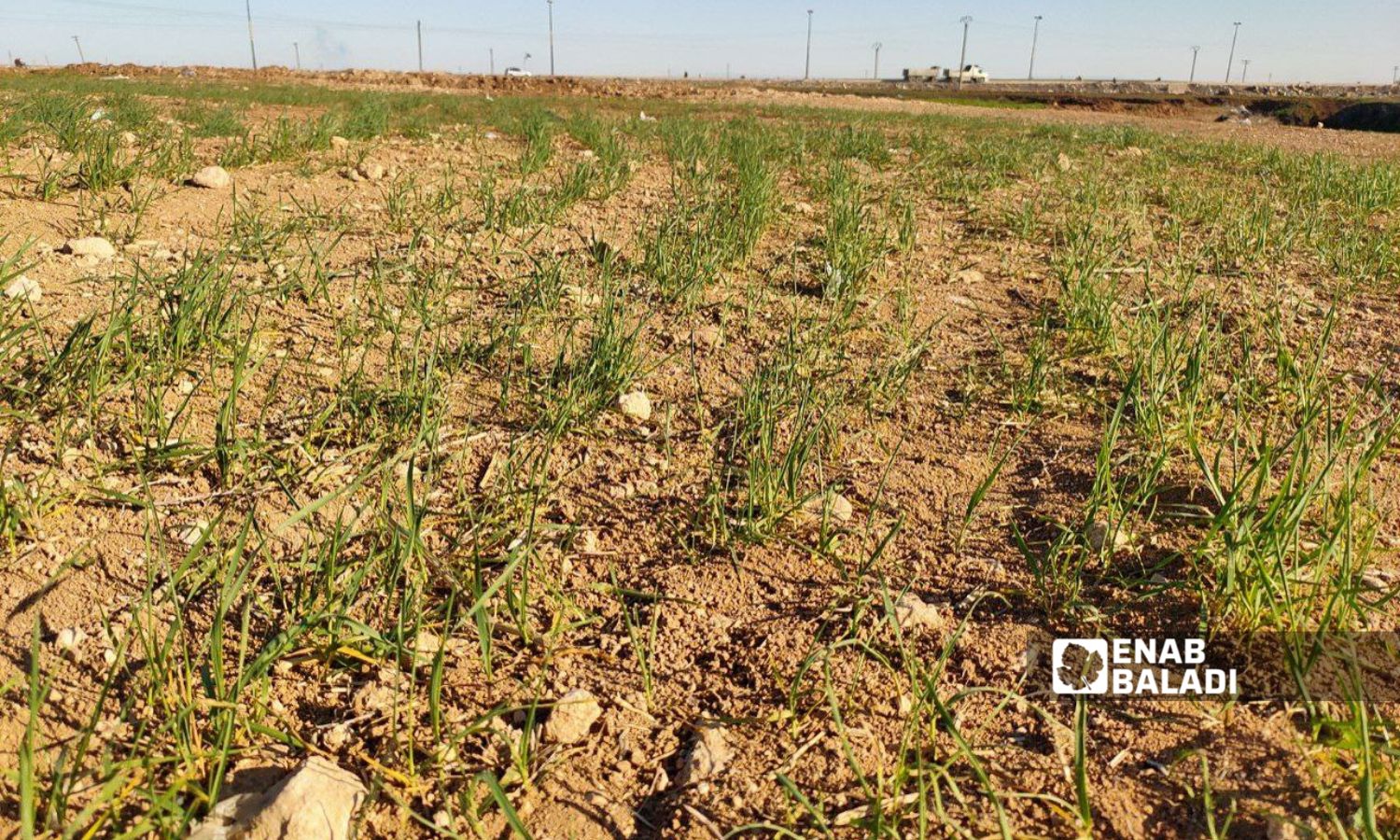



Al-Hasakah – Majd al-Salem
Eight hectares owned by 50-something-year-old farmer Ahmad al-Mukhaylif have become barren due to low rainfall and drought in the village of al-Mushayrifah south of Qamishli, resulting in the loss of his barley crop.
As far as the eye can see, al-Mukhaylif points to the surrounding lands which have all turned into “barren empty spaces.”
Al-Mukhaylif told Enab Baladi that farmers, especially those relying on rainwater for irrigating their lands, have suffered losses amounting to millions of Syrian pounds due to the drought.
The situation of farmer al-Mukhaylif mirrors that of hundreds of farmers in the city of al-Hasakah, as drought has caused financial losses for them this season.
Hamid al-Aswad (aged 60) from the southern countryside of Tal Hamis considers his losses to be doubled due to drought and low rainfall.
Al-Aswad told Enab Baladi that he planted about 80 hectares with barley to secure fodder for his flock of sheep, as he usually stores barley and hay to avoid having to buy them from merchants.
The low rainfall this year has caused him to lose his entire cultivated area, meaning he will have to bear the costs of farming and preparing the land and seeds, while also being forced to buy what he needs in fodder from merchants at high prices.
The negative effects of low rainfall are not limited to dry farming; they extend to irrigated areas that depend on rivers or artesian wells.
Ibrahim al-Hamid (aged 40) from the village of al-Suqiya south of Qamishli told Enab Baladi that the low rainfall has increased his irrigation costs for his wheat crop (10 hectares) by about 50%, as during rainy days, he usually stops the pumps for several days, sometimes up to a week, which usually saves him “good” amounts of fuel.
Agricultural engineer Tarek al-Ayed (aged 40) from al-Hasakah told Enab Baladi that the absence of rain is a crucial factor in the increase of agricultural production costs, as most farmers rely on water pumps to operate irrigation projects continuously. Rainfall reduces fuel consumption for running the pumps, which has not occurred in this season.
The engineer added that this has also led to the drying up of some wells and a significant drop in water levels, making it more difficult to obtain the necessary water for irrigation. Some farmers have had to increase the depth of their pumps to reach deep water, which all raises costs.
According to what Enab Baladi learned from several farmers, the Autonomous Administration of North and East Syria (AANES) allocates fuel to projects based on the depth of the pump, providing projects with pumps less than 50 meters deep with 12 liters of diesel per dunam, for depths of 51-100 meters 20 liters per dunam, and for depths of 101-150 meters 25 liters per dunam.
If the pump is deeper than 150 meters, 30 liters are allocated per dunam, but these quantities are not always provided in full, and there is usually a delay in disbursing allocations, forcing farmers to buy diesel from the black market at the price of 5,000 Syrian pounds per liter.
Fifty-something-year-old Khalid al-Wadi from eastern Tal Hamis resorted to renting his land (9 hectares) to local sheep breeders to minimize his losses as much as possible, after he lost hope of obtaining any production from it during the current season, according to his statements to Enab Baladi.
The price of renting a dunam of land as pasture for sheep ranges from 15,000 to 50,000 Syrian pounds, depending on the condition of the crop.
So far, there are no official statistics regarding the extent of damaged areas in the governorate as a result of the drought, while AANES has issued a decision restricting the transportation of agricultural products such as wheat, barley, corn, and cotton outside the governorate due to the drought.
The water shortage crisis in Syria is intensifying day by day, and water levels are dropping to unprecedented levels, with major water sources drying up and others on the verge of drying out. Parties to the conflict have contributed to the destruction of the infrastructure that used to provide water services.
The Global Conflict Risk Index for 2022 considered Syria to be the most drought-prone country in the Mediterranean region, and the United Nations warned that drought waves in this area will increase in length and intensity, making access to clean drinking water a challenge for millions of Syrians.
if you think the article contain wrong information or you have additional details Send Correction